各个时态的基本句型
英语时态基本句型结构与用法知识点总结归纳

英语时态基本句型结构与用法知识点总结归纳英语时态基本句型结构与用法总结八大时态:一般现在时、一般过去时、现在进行时、过去进行时、现在完成时、过去完成时、一般将来时、过去将来时一般现在时1.概念:指经常、反复发生的动作或行为及现在的某种状况。
2.时间状语:always, usually, often, sometimes, every week (day, year, month…), once a week, on Sundays,3.基本结构:动词+ 原形(如主语为第三人称单数,动词上要加(e)S)4.否定形式:am/is/are+not;此时态的谓语动词若为行为动词,则在其前加dont,如主语为第三人称单数,则用doesnt,同时还原行为动词。
5.一般疑问句:把be动词放于句首;用助动词do提问,如主语为第三人称单数,则用does,同时,还原行为动词。
6.例句:. It seldom snows here.He is always ready to help others.Action speaks louder than words.7.特殊用法:一些动词可用一般现在时来表达现在进行时:verbs of the senses: hear,see,taste,smellverbs of the thinking: believe,know,mean,realize,think,rememberverbs of the linking: dislike,fear,hate,like,love,wantverbs of the possession: belong,have,own,possess一般过去时1.概念:过去某个时间里发生的动作或状态;过去习惯性、经常性的动作、行为。
2.时间状语:ago, yesterday, the day before yesterday, last week(year, night, month…), in 1989, just now, at the age of 5, one day, long long ago, once upon a time, etc.3.基本结构:含有Be动词主语+was/were+......不含有be动词:主语+动词过去式+......4.否定句:带be:主语+was/were not+动词原形+......不带be:主语+didnt+动词原形+......5.一般疑问句:含be动词was或were放于句首;不含be动词用助动词do的过去式did 提问,同时还原行为动词原型。
英语的各种时态句型
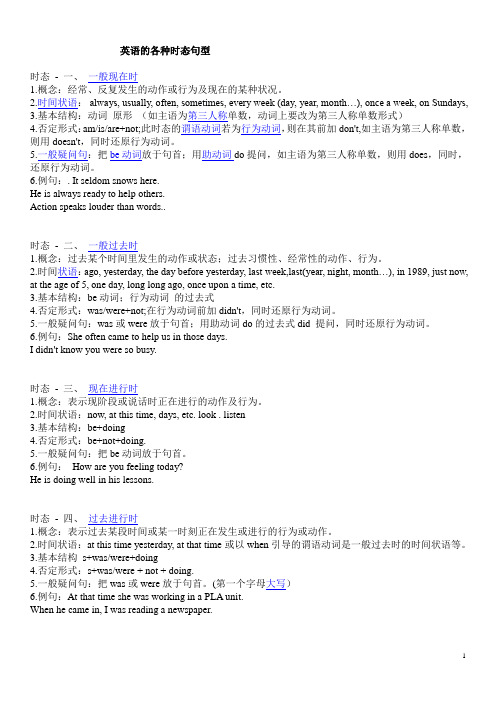
英语的各种时态句型时态- 一、一般现在时1.概念:经常、反复发生的动作或行为及现在的某种状况。
2.时间状语:always, usually, often, sometimes, every week (day, year, month…), once a week, on Sundays,3.基本结构:动词原形(如主语为第三人称单数,动词上要改为第三人称单数形式)4.否定形式:am/is/are+not;此时态的谓语动词若为行为动词,则在其前加don't,如主语为第三人称单数,则用doesn't,同时还原行为动词。
5.一般疑问句:把be动词放于句首;用助动词do提问,如主语为第三人称单数,则用does,同时,还原行为动词。
6.例句:. It seldom snows here.He is always ready to help others.Action speaks louder than words..时态- 二、一般过去时1.概念:过去某个时间里发生的动作或状态;过去习惯性、经常性的动作、行为。
2.时间状语:ago, yesterday, the day before yesterday, last week,last(year, night, month…), in 1989, just now, at the age of 5, one day, long long ago, once upon a time, etc.3.基本结构:be动词;行为动词的过去式4.否定形式:was/were+not;在行为动词前加didn't,同时还原行为动词。
5.一般疑问句:was或were放于句首;用助动词do的过去式did 提问,同时还原行为动词。
6.例句:She often came to help us in those days.I didn't know you were so busy.时态- 三、现在进行时1.概念:表示现阶段或说话时正在进行的动作及行为。
高中英语必备基础句型和8大时态结构
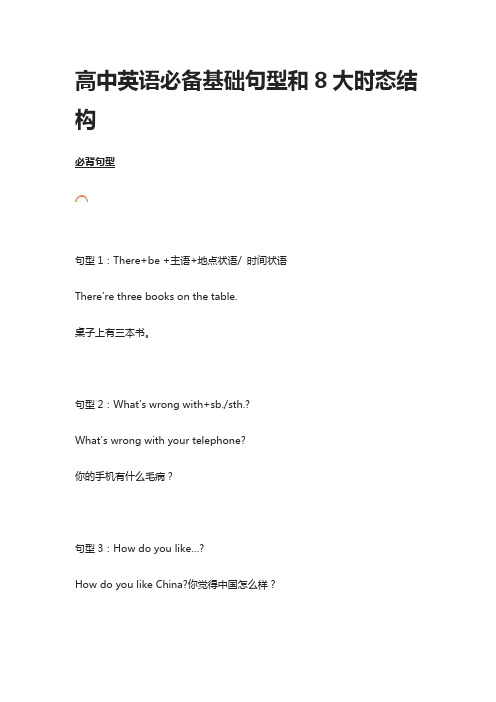
高中英语必备基础句型和8大时态结构必背句型句型1:There+be +主语+地点状语/ 时间状语There're three books on the table.桌子上有三本书。
句型2:What's wrong with+sb./sth.?What's wrong with your telephone?你的手机有什么毛病?句型3:How do you like…?How do you like China?你觉得中国怎么样?句型4:What do you like about…?What do you like about China?你喜欢中国的什么?句型5:had better(not)+动词原形You'd better ask that policeman over there. 你最好去问问那边的那个警察。
句型7:Thank+sb.+for (doing) sth. Thank you for coming to see me.感谢你来看我。
句型8:So+be/情态动词/助动词+主语He is a student. So am I.他是一个学生,我也是。
句型9:not…until…He didn't have supper until his parents came back.直到他的父母回来他才吃饭。
句型10:比较级十and+比较级The baby cried harder and harder.那孩子哭得越来越厉害。
句型11:the+比较级,the+比较级The more one has,the more one wants.拥有的越多,想要的越多。
句型12:…as+adj./adv.+as……not as(so)+adj./adv.+as…Last Sunday the weather was not so wet as it is today. 上个星期天的天气不如今天的天气潮湿。
英语各种时态的构成

英语各种时态的构成英语时态是英语语法中的重要部分,它表示动作发生的时间和状态。
以下是各种时态的构成:1. 一般现在时态:表示经常发生的动作或存在的状态。
基本形式为动词原形,第三人称单数时在动词后面加-s/-es。
例如:I read books every day.2. 现在进行时态:表示正在进行的动作。
基本形式为be动词+动词ing形式。
例如:He is reading a book now.3. 现在完成时态:表示已经完成的动作或存在的状态。
基本形式为have/has+过去分词。
例如:I have read the book already.4. 现在完成进行时态:表示刚刚完成的动作。
基本形式为have/has been+动词ing形式。
例如:He has been working hard all day.5. 一般过去时态:表示过去的动作或存在的状态。
基本形式为动词过去式。
例如:She read a book yesterday.6. 过去进行时态:表示过去正在进行的动作。
基本形式为was/were+动词ing形式。
例如:They were playing basketball at 3 o’clock yesterday afternoon.7. 过去完成时态:表示过去的某个时间之前已经完成的动作。
基本形式为had+过去分词。
例如:They had finished their homework before dinner.8. 过去完成进行时态:表示过去的某个时间之前一直在进行的动作。
基本形式为had been+动词ing形式。
例如:He had been waiting for the bus for hours when I arrived.。
有关时态的九大句型

现在进行时强调当前正在进行的动作,而过去进行时强调过去某个时间正在进行的动作。根据语境的需 要,可以在现在进行时和过去进行时之间进行转换。
时态的特殊用法与注意事项
时态的一致性
在描述一系列动作或事件时,应 注意保持时态的一致性,避免混 用不同时态导致语义混淆。
语境与时态
应根据语境选择合适的时态。例 如,在描述历史事件、新闻报道 等正式文体中,应使用过去时态; 在描述个人经历、对话等非正式 文体中,可以使用现在进行时或 过去进行时。
过去将来完成时
总结词
表示过去某时将已经完成的动作
详细描述
过去将来完成时表示在过去某个时间,预期将来某个时间点会已经完成某个动作。其基本结构是“would have + -ed”,例如“He thought they would have left by the time he got there.”。
过去时态的特殊用法
详细描述:在英语中,过去时态 常用于表达过去的经历、历史事 件、虚构故事等,同时还可以表 示礼貌、委婉语气等。
例句:He said he would come, but he didn't. (表示过去的经历)
The story took place in the past. (表示历史事件)
详细描述
将来完成进行时态表示某个动作在将来某个 时间点之前已经开始,并且这个动作会一直 持续到那个时间点。这个时态强调动作的持 续性,以及动作在将来某个时间点之前已经 存在的情况。
将来完成进行时的用法
总结词
用于描述计划、安排或预计在将来某个时间点之前已经持续进行的动作
详细描述
将来完成进行时态常用于描述计划、安排或预计在将来某个时间点之前已经持续进行的 动作。这个时态强调动作的计划性、安排性或预计性,以及动作在将来某个时间点之前
时态和语态-基本句型

7
基本句型四:S +V +IO +O(主+谓+间宾+直 宾)
S V(及物) IO(多指 人)
O(多指物)
1. She passed him
2. She cooked her
3. She brought me
4. He bought you
5. I showed her
6. I gave
him
7. I told
➢ 基本句型五:S +V +O +C(主+谓+宾+宾补)
➢ 基本句型六:There be 句式
3
基本句型一:S +V (主+谓)
S
1. Time 2. The moon 3. The man 4. An accident 5. Everybody 6. I 7. They 8. He 9.They
Practice
Work on the following sentences and try to anlyze which pattern they belong to. 判断下列句子属于哪种基本 句式
1) Both men speak loudly and clearly.
S+V 主+谓+状
其他关系:wish name make call
基本句型五:S +V +O +C(主+谓+宾+宾补)
S
V(及物) O(宾语)
C(宾补)
1. We 2. They 3. They 4. They 5. What 6. We 7. He 8. I
keep painted call found makes saw asked saw
八种英语时态基本句型
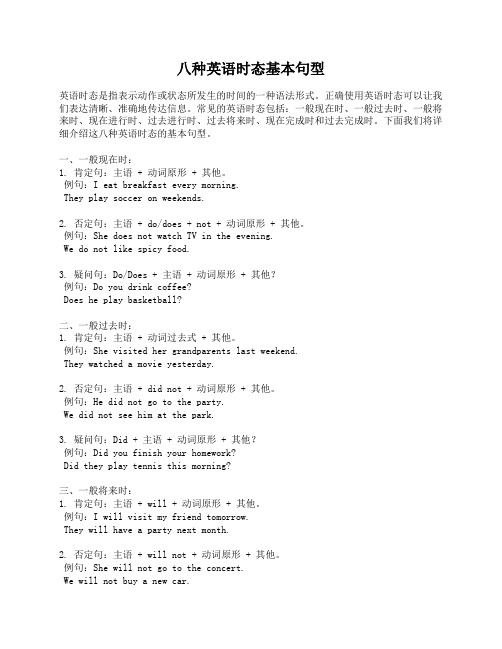
八种英语时态基本句型英语时态是指表示动作或状态所发生的时间的一种语法形式。
正确使用英语时态可以让我们表达清晰、准确地传达信息。
常见的英语时态包括:一般现在时、一般过去时、一般将来时、现在进行时、过去进行时、过去将来时、现在完成时和过去完成时。
下面我们将详细介绍这八种英语时态的基本句型。
一、一般现在时:1. 肯定句:主语 + 动词原形 + 其他。
例句:I eat breakfast every morning.They play soccer on weekends.2. 否定句:主语 + do/does + not + 动词原形 + 其他。
例句:She does not watch TV in the evening.We do not like spicy food.3. 疑问句:Do/Does + 主语 + 动词原形 + 其他?例句:Do you drink coffee?Does he play basketball?二、一般过去时:1. 肯定句:主语 + 动词过去式 + 其他。
例句:She visited her grandparents last weekend.They watched a movie yesterday.2. 否定句:主语 + did not + 动词原形 + 其他。
例句:He did not go to the party.We did not see him at the park.3. 疑问句:Did + 主语 + 动词原形 + 其他?例句:Did you finish your homework?Did they play tennis this morning?三、一般将来时:1. 肯定句:主语 + will + 动词原形 + 其他。
例句:I will visit my friend tomorrow.They will have a party next month.2. 否定句:主语 + will not + 动词原形 + 其他。
小学六年级英语三大时态笔记
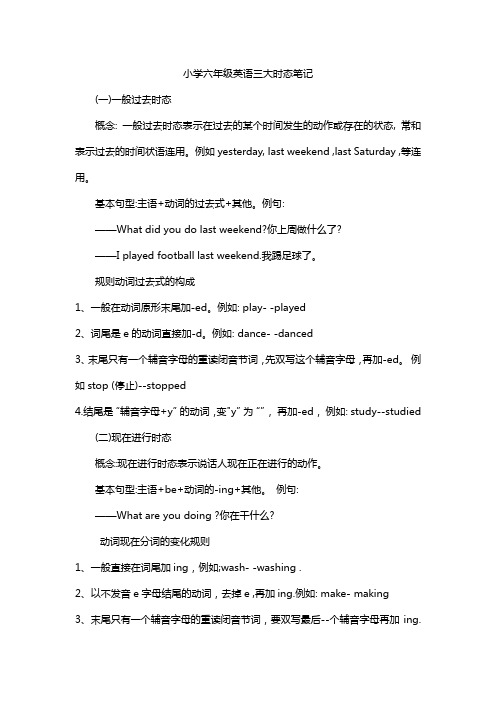
小学六年级英语三大时态笔记(一)一般过去时态概念: 一般过去时态表示在过去的某个时间发生的动作或存在的状态, 常和表示过去的时间状语连用。
例如yesterday, last weekend ,last Saturday ,等连用。
基本句型:主语+动词的过去式+其他。
例句:——What did you do last weekend?你上周做什么了?——I played football last weekend.我踢足球了。
规则动词过去式的构成1、一般在动词原形末尾加-ed。
例如: play- -played2、词尾是e的动词直接加-d。
例如: dance- -danced3、末尾只有一个辅音字母的重读闭音节词,先双写这个辅音字母,再加-ed。
例如stop (停止)--stopped4.结尾是“辅音字母+y”的动词,变"y”为“”,再加-ed,例如: study--studied(二)现在进行时态概念:现在进行时态表示说话人现在正在进行的动作。
基本句型:主语+be+动词的-ing+其他。
例句:——What are you doing ?你在干什么?动词现在分词的变化规则1、一般直接在词尾加ing,例如;wash- -washing .2、以不发音e字母结尾的动词,去掉e ,再加ing.例如: make- making3、末尾只有一个辅音字母的重读闭音节词,要双写最后--个辅音字母再加ing.例如swim- swimming(三) 一般将来时态概念: 一般将来时态表示将来某一-时间或某- -段时间内发生的动作或存在的状态。
常与表示将来的时间如tomorrow ,this afternoon等连用。
通常用will,be going to+动词原形来表示一般将来时态。
基本句型:①主语+will+动词原形+其他。
②主语+be going to +动词原形+其他。
英语9大时态+3大从句+20个核心句型,必须吃透!

英语9大时态+3大从句+20个核心句型,必须吃透!九种基本时态一、一般现在时概念:表示经常发生的动作或经常存在的状态。
常和always,often,usually,sometimes,every day等表时间的状语连用。
如:1)I go to school every day.我每天都去学校。
(表经常)2)He is always like that.他总是那样。
(表状态)构成:1)主语+be(am/are/is).+..……2)主语+实义动词+…二、一般过去时概念:1)表示过去某个时间发生的动作或存在的状态。
常和表示过去的时间状语连用。
如:yesterday,last week,in 1998,two days ago等。
如:I went to a movie yesterday.我昨天去看了一场电影。
2)也可表示过去经常或反复发生的动作。
如:He always went to work by bike last week.构成:1)主语+be(was/were)+.……2)主语+实义动词过去式+…三、现在进行时概念:表示现在(说话瞬间)正在进行或发生的动作。
如:He is singing.They are watching TV now.构成:主语+助动词be(am/are/is)+动词-ing形式构成.四、过去进行时概念:表示过去某一时刻或某一段时间正在进行的动作。
这一特定的过去时间除了有上下文暗示外,一般用时间状语来表示。
如:1)--What were you doing?-I was jumping.2)--What was the boy doing when the UFO arrived?--He was sleeping.构成:主语+助动词be(was/were)+动词-ing形式构成。
五、一般将来时概念:表示将来某个时间要发生的动作或存在的状态,也表示将来经常或反复发生的动作,常与表示将来的时间状语连用。
初中英语9大时态+6大词性+3大从句+70个句型
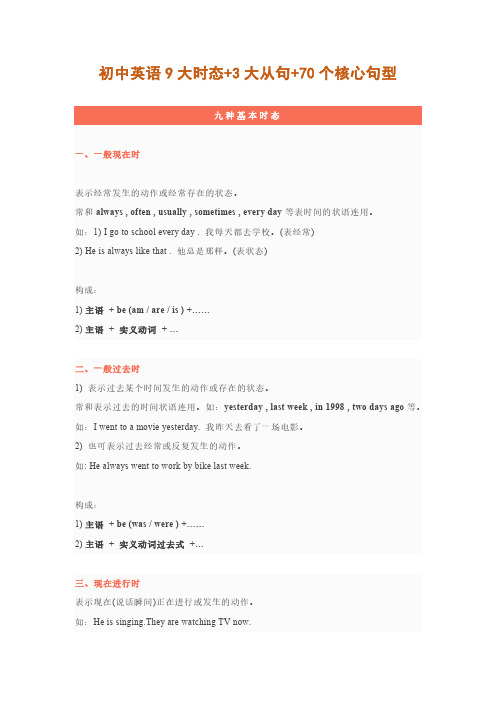
初中英语9大时态+3大从句+70个核心句型九种基本时态一、一般现在时表示经常发生的动作或经常存在的状态。
常和always , often , usually , sometimes , every day等表时间的状语连用。
如:1) I go to school every day . 我每天都去学校。
(表经常)2) He is always like that . 他总是那样。
(表状态)构成:1) 主语+ be (am / are / is ) +……2) 主语+ 实义动词+ …二、一般过去时1) 表示过去某个时间发生的动作或存在的状态。
常和表示过去的时间状语连用。
如:yesterday , last week , in 1998 , two days ago等。
如:I went to a movie yesterday. 我昨天去看了一场电影。
2) 也可表示过去经常或反复发生的动作。
如: He always went to work by bike last week.构成:1) 主语+ be (was / were ) +……2) 主语+ 实义动词过去式+…三、现在进行时表示现在(说话瞬间)正在进行或发生的动作。
如:He is singing.They are watching TV now.构成:主语+ 助动词be(am/are/is) + 动词-ing形式构成四、过去进行时表示过去某一时刻或某一段时间正在进行的动作。
这一特定的过去时间除了有上下文暗示外,一般用时间状语来表示。
如:1) ---What were you doing?---I was jumping.2) ---What was the boy doing when the UFO arrived?---He was sleeping.构成:主语+ 助动词be(was/were) + 动词-ing形式构成.五、一般将来时表示将来某个时间要发生的动作或存在的状态,也表示将来经常或反复发生的动作。
英语八大时态总结表 8种基本时态结构句型
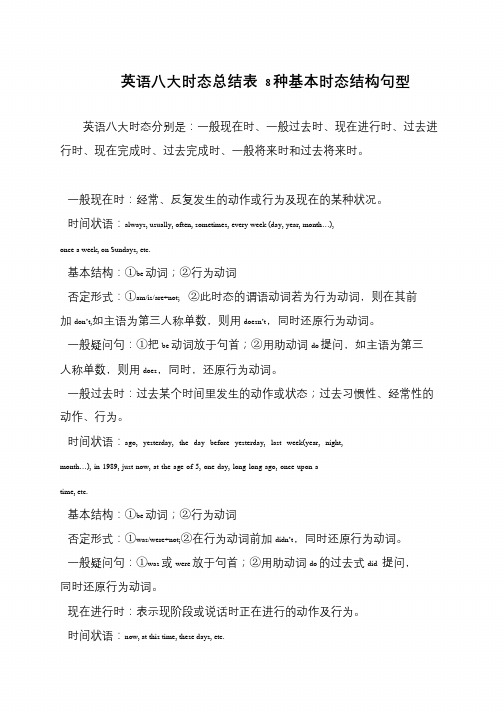
英语八大时态总结表8 种基本时态结构句型英语八大时态分别是:一般现在时、一般过去时、现在进行时、过去进行时、现在完成时、过去完成时、一般将来时和过去将来时。
一般现在时:经常、反复发生的动作或行为及现在的某种状况。
时间状语:always, usually, often, sometimes, every week (day, year, month…),once a week, on Sundays, etc.基本结构:①be 动词;②行为动词否定形式:①am/is/are+not; ②此时态的谓语动词若为行为动词,则在其前加don’t,如主语为第三人称单数,则用doesn’t,同时还原行为动词。
一般疑问句:①把be 动词放于句首;②用助动词do 提问,如主语为第三人称单数,则用does,同时,还原行为动词。
一般过去时:过去某个时间里发生的动作或状态;过去习惯性、经常性的动作、行为。
时间状语:ago, yesterday, the day before yesterday, last week(year, night,month…), in 1989, just now, at the age of 5, one day, long long ago, once upon atime, etc.基本结构:①be 动词;②行为动词否定形式:①was/were+not;②在行为动词前加didn’t,同时还原行为动词。
一般疑问句:①was 或were 放于句首;②用助动词do 的过去式did 提问,同时还原行为动词。
现在进行时:表示现阶段或说话时正在进行的动作及行为。
时间状语:now, at this time, these days, etc.。
英语的各种时态句型

英语的各种时态句型英语有多种时态,包括一般现在时、一般过去时、一般将来时、现在进行时、过去进行时、将来进行时、现在完成时、过去完成时、将来完成时、现在完成进行时、过去完成进行时、将来完成进行时等。
以下是一些常见的英语时态句型:一般现在时:1. He usually goes to work by car。
2. They play tennis every Sunday。
3. I like to read books in my free time。
一般过去时:1. She studied English in college。
2. We went to the beach last summer。
3. He played football when he was younger。
一般将来时:1. I will visit my family next week。
2. They are going to have a party tomorrow。
3. We are leaving for vacation in two days。
现在进行时:1. She is studying for her exams。
2. They are playing basketball in the park。
3. He is working on a new project at the office。
过去进行时:1. She was studying when I called her。
2. They were playing chess at the time。
3. He was working on his car all afternoon。
将来进行时:1. They will be traveling to Europe next month。
2. She will be attending a conference next week。
初中英语八种时态基本句型
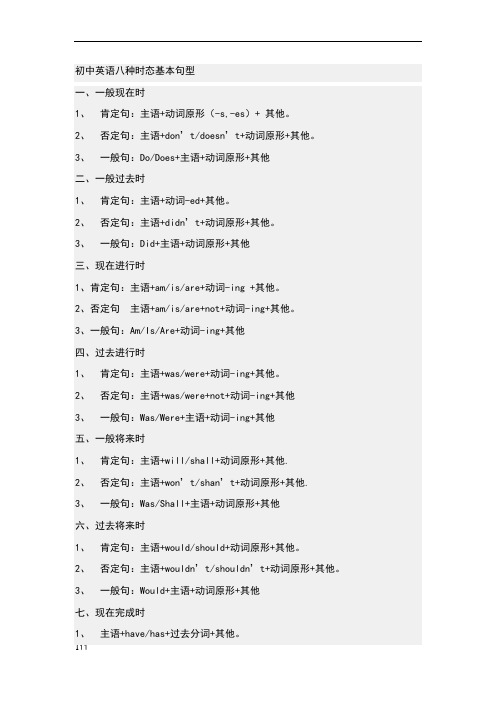
初中英语八种时态基本句型一、一般现在时1、肯定句:主语+动词原形(-s,-es)+ 其他。
2、否定句:主语+don’t/doesn’t+动词原形+其他。
3、一般句:Do/Does+主语+动词原形+其他二、一般过去时1、肯定句:主语+动词-ed+其他。
2、否定句:主语+didn’t+动词原形+其他。
3、一般句:Did+主语+动词原形+其他三、现在进行时1、肯定句:主语+am/is/are+动词-ing +其他。
2、否定句主语+am/is/are+not+动词-ing+其他。
3、一般句:Am/Is/Are+动词-ing+其他四、过去进行时1、肯定句:主语+was/were+动词-ing+其他。
2、否定句:主语+was/were+not+动词-ing+其他3、一般句:Was/Were+主语+动词-ing+其他五、一般将来时1、肯定句:主语+will/shall+动词原形+其他.2、否定句:主语+won’t/shan’t+动词原形+其他.3、一般句:Was/Shall+主语+动词原形+其他六、过去将来时1、肯定句:主语+would/should+动词原形+其他。
2、否定句:主语+wouldn’t/shouldn’t+动词原形+其他。
3、一般句:Would+主语+动词原形+其他七、现在完成时1、主语+have/has+过去分词+其他。
2、主语+haven’t/hasn’t+过去分词+其他。
3、 Have/Has+主语+过去分词+其他八、过去完成时1、肯定句:主语+had+过去分词+其他。
2、否定句:主语+hadn’t+过去分词+其他。
3、一般句:Had+主语+过去分词+其他A)、名词的数名词可以分为可数名词和不可数名词,而不可数名词它没有复数形式,但可数名词却有单数和复数之分,复数的构成如下:一)在后面加s。
如:fathers, books, Americans, Germans, apples, bananas 二)x, sh, ch, s, tch后加es。
英语五种基本句型与八大时态

英语五种基本句型列式如下:基本句型一: S V (主+谓)基本句型二: S V P (主+谓+表)基本句型三: S V O (主+谓+宾)基本句型四: S V o O (主+谓+间宾+直宾)基本句型五; S V O C (主+谓+宾+宾补)八大时态一、一般现在时:1.概念:经常、反复发生的动作或行为及现在的某种状况。
2.时间状语: always, usually, often, sometimes, every week (day, year, month…), once a week, on Sundays,3.基本结构:动词原形(如主语为第三人称单数,动词上要加(e)S)4.否定形式:am/is/are+not;此时态的谓语动词若为行为动词,则在其前加don't,如主语为第三人称单数,则用doesn't,同时还原行为动词。
5.一般疑问句:把be动词放于句首;用助动词do提问,如主语为第三人称单数,则用does,同时,还原行为动词。
6.例句:. It seldom snows here.He is always ready to help others.Action speaks louder than words.二、一般过去时:1.概念:过去某个时间里发生的动作或状态;过去习惯性、经常性的动作、行为。
2.时间状语:ago, yesterday, the day before yesterday, last week(year, night, month…), in 1989, just now, at the age of 5, one day, long long ago, once upon a time, etc.3.基本结构:be动词;行为动词4.否定形式:was/were+not;在行为动词前加didn't,同时还原行为动词。
5.一般疑问句:was或were放于句首;用助动词do的过去式did 提问,同时还原行为动词。
英语各种时态的概念和句型结构

英语各种时态的概念和句型结构一、一般现在时1、概念:表示经常性、习惯性的动作。
2、句型结构(1)be(am,is,are)动词陈述肯定句:主语+be(am,is,are)+其它。
陈述否定句:主语+be(am,is,are)+not+其它。
一般疑问句:Be(am,is,are)+主语+其它特殊疑问句:疑问词+一般疑问句Who are they反意疑问句:肯定陈述句+be(am,is,are)+not+主语(相应的代词)Tom is a doctor, isn’t he否定陈述句,+be(am,is,are)+主语(相应的代词)Tom isn’t a doctor , is he(2)实义动词陈述肯定句:其他人称:主语+v.原形+其它。
We go to the beach every Sunday.第三人称单数:主语++其它。
Sally does her homework every day.陈述否定句:其他人称:主语+don’t+v.原形+其它。
We don’t go to the beach every Sunday.第三人称单数:主语+doesn’t+v.原形+其它。
Sally doesn’t do her homework every day.一般疑问句:其他人称:Do+主语+v.原形+其它Do we go to the beach every Sunday第三人称单数:Does+主语+v.原形+其它Does Sally do her homework every day特殊疑问句:疑问词+一般疑问句其他人称:Where do you go every Sunday第三人称单数:What does Sally do every day反意疑问句:肯定陈述句,+don’t/doesn’t+主语(相应的代词)其他人称:We go to the beach every Sunday, don’t we第三人称单数:Sally does her homework every day, doesn’t she否定陈述句,+do/does+主语(相应的代词)其他人称:We don’t go to the beach every Sunday , do we第三人称单数:Sally doesn’t do her homework every day , does she二、一般过去时1、概念:表示过去某个时间发生的动作或存在的状态。
英语八大时态基本句型及例句

英语八大时态基本句型及例句英语中有八种基本时态,包括:现在简单时态、现在进行时态、现在完成时态、过去简单时态、过去进行时态、过去完成时态、将来简单时态和将来完成时态。
以下是每种时态的基本句型及例句:1. 现在简单时态(Present Simple Tense)基本句型:主语 + 动词原形(第三人称单数加s)例句:My sister reads books every day.(我姐姐每天都读书。
) 2. 现在进行时态(Present Continuous Tense)基本句型:主语 + am/is/are + 现在分词例句:I am studying English now.(我正在学英语。
)3. 现在完成时态(Present Perfect Tense)基本句型:主语 + have/has + 过去分词例句:She has visited many countries.(她去过很多国家。
) 4. 过去简单时态(Past Simple Tense)基本句型:主语 + 过去式动词例句:He went to the beach last weekend.(上周末他去了海滩。
)5. 过去进行时态(Past Continuous Tense)基本句型:主语 + was/were + 现在分词例句:They were playing basketball when it started to rain.(当下雨时他们正在打篮球。
)6. 过去完成时态(Past Perfect Tense)基本句型:主语 + had + 过去分词例句:I had finished my homework before my friends arrived.(朋友到达之前我已经完成了作业。
)7. 将来简单时态(Future Simple Tense)基本句型:主语 + will + 动词原形例句:I will help you with your project tomorrow.(我明天会帮你做项目。
五种句型、七大语法、八大时态
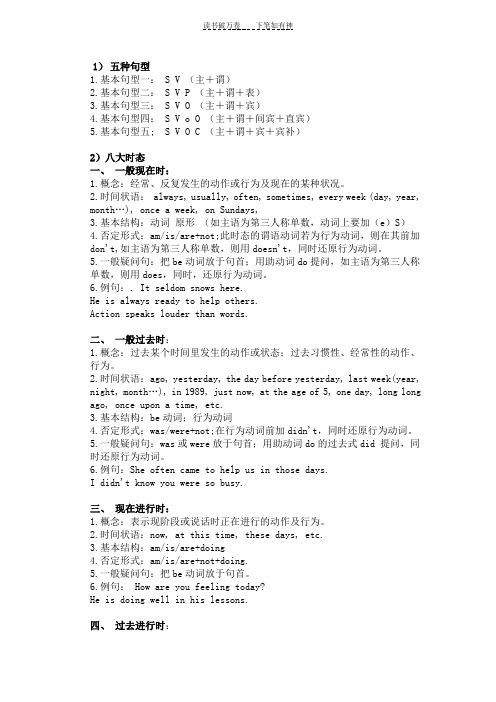
1)五种句型1.基本句型一: S V (主+谓)2.基本句型二: S V P (主+谓+表)3.基本句型三: S V O (主+谓+宾)4.基本句型四: S V o O (主+谓+间宾+直宾)5.基本句型五; S V O C (主+谓+宾+宾补)2)八大时态一、一般现在时:1.概念:经常、反复发生的动作或行为及现在的某种状况。
2.时间状语: always, usually, often, sometimes, every week (day, year, month…), once a week, on Sundays,3.基本结构:动词原形(如主语为第三人称单数,动词上要加(e)S)4.否定形式:am/is/are+not;此时态的谓语动词若为行为动词,则在其前加don't,如主语为第三人称单数,则用doesn't,同时还原行为动词。
5.一般疑问句:把be动词放于句首;用助动词do提问,如主语为第三人称单数,则用does,同时,还原行为动词。
6.例句:. It seldom snows here.He is always ready to help others.Action speaks louder than words.二、一般过去时:1.概念:过去某个时间里发生的动作或状态;过去习惯性、经常性的动作、行为。
2.时间状语:ago, yesterday, the day before yesterday, last week(year, night, month…), in 1989, just now, at the age of 5, one day, long long ago, once upon a time, etc.3.基本结构:be动词;行为动词4.否定形式:was/were+not;在行为动词前加didn't,同时还原行为动词。
5.一般疑问句:was或were放于句首;用助动词do的过去式did 提问,同时还原行为动词。
各个时态的句子结构及标志词
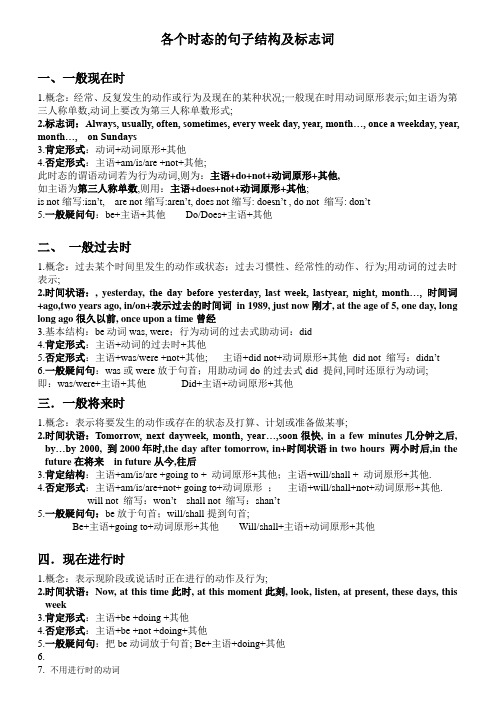
各个时态的句子结构及标志词一、一般现在时1.概念:经常、反复发生的动作或行为及现在的某种状况;一般现在时用动词原形表示;如主语为第三人称单数,动词上要改为第三人称单数形式;2.标志词:Always, usually, often, sometimes, every week day, year, month…, once a weekday, year, month…, on Sundays3.肯定形式:动词+动词原形+其他4.否定形式:主语+am/is/are +not+其他;此时态的谓语动词若为行为动词,则为:主语+do+not+动词原形+其他,如主语为第三人称单数,则用:主语+does+not+动词原形+其他;is not缩写:isn’t, are not缩写:aren’t, does not缩写: doesn’t , do not 缩写: don’t5.一般疑问句:be+主语+其他Do/Does+主语+其他二、一般过去时1.概念:过去某个时间里发生的动作或状态;过去习惯性、经常性的动作、行为;用动词的过去时表示;2.时间状语:, yesterday, the day before yesterday, last week, lastyear, night, month…, 时间词+ago,two years ago, in/on+表示过去的时间词in 1989, just now刚才, at the age of 5, one day, long long ago很久以前, once upon a time曾经3.基本结构:be动词was, were;行为动词的过去式助动词:did4.肯定形式:主语+动词的过去时+其他5.否定形式:主语+was/were +not+其他; 主语+did not+动词原形+其他did not 缩写:didn’t6.一般疑问句:was或were放于句首;用助动词do的过去式did 提问,同时还原行为动词;即:was/were+主语+其他Did+主语+动词原形+其他三.一般将来时1.概念:表示将要发生的动作或存在的状态及打算、计划或准备做某事;2.时间状语:Tomorrow, next dayweek, month, year…,soon很快, in a few minutes几分钟之后,b y…by 2000, 到2000年时,the day after tomorrow, in+时间状语in two hours 两小时后,in the future在将来in future从今,往后3.肯定结构:主语+am/is/are +going to + 动词原形+其他;主语+will/shall + 动词原形+其他.4.否定形式:主语+am/is/are+not+ going to+动词原形;主语+will/shall+not+动词原形+其他.will not 缩写:won’t shall not 缩写:shan’t5.一般疑问句:be放于句首;will/shall提到句首;Be+主语+going to+动词原形+其他Will/shall+主语+动词原形+其他四.现在进行时1.概念:表示现阶段或说话时正在进行的动作及行为;2.时间状语:Now, at this time此时, at this moment此刻, look, listen, at present, these days, this week3.肯定形式:主语+be +doing +其他4.否定形式:主语+be +not +doing+其他5.一般疑问句:把be动词放于句首; Be+主语+doing+其他6.7. 不用进行时的动词1 事实状态的动词:have, belong, possess, cost, owe, exist, include, contain, matter, weigh, measure, continueI have two brothers.This house belongs to my sister.2心理状态的动词: know, realize, think see, believe, suppose, imagine, agree, recognize, remember, want, need, forget, prefer, mean, understand, love, hateI need your help.He loves her very much.3 瞬间动词:accept, receive, complete, finish, give, allow, decide, refuse.I accept your advice.4系动词:seem, remain, lie, see, hear, smell, feel, taste, get, become, turnYou seem a little tired.五. 过去进行时1. 概念:过去进行时主要表示过去某一时刻正在进行的动作,或表示过去某一阶段一直在进行的动作2. 过去进行时的主要用法是描述一件事发生的背景;一个长动作发生的时候,另一个短动作发生;3. 常用的时间状语: just then那时, at this time yesterday, yesterday afternoon, at that time, this morning, the whole morning, the whole morning, all day yesterday, from nine to ten last evening, those days或以when, while引导的谓语动词是一般过去时的时间状语等;否定句则在was/were后加一个not,疑问句将was/were提前则可;如:He was reading a book at 5:00pm yesterday.→He was not reading a book at 5:00 yesterday.→Was he reading a book at 5:00 yesterdayYes, he was./ No, he wasn’t.→What was he doing at 5:00 yesterday5.1也就是说用一般过去时,只表示有过这件事;用过去进行时,则强调动作的连续性;①I wrote a letter this morning. 今天上午我写了一封信;信写完了I was writing a letter this morning. 今天上午我在写一封信;信不一定写完②The children watched TV yesterday evening. 昨天晚上孩子们看了电视;强调过去发生了这件事The children were watching TV yesterday evening. 昨晚孩子们都在看电视;强调昨晚看电视这一动作的持续性7.when和while的区别:他们作从属连词时都有“当……. 时候”之意,用法稍有不同:①when引导的时间状语从句的谓语动词可以是短暂性动词,也可以是延续性动词,而while引导的时间状语从句中的谓语动词只能是延续性动词;②when引导的从句谓语动词如果是短暂性动词则用一般过去时,主句是延续性动词则用过去进行时,从句动作发生在主句动作的时间段之内长动作用过去进行时,短动作用一般过去时;如果主句和从句两个谓语动词都是延续性动词则全部用过去进行时,这时when和while都可以用;③when从句的谓语动词可以在主句谓语动作之前、之后或同时发生;while和as从句的谓语动作必须是和主句谓语动作同时发生;④when和while两个词还可以用作并列连词,但意思不同,when相当于“在那时”,等于at that time或just then;而while则相当于“而;却;但是”;相当于but,表示对比关系;这一点暂时可以不掌握eg.⑴ I was playing computer games when my father got home.= When my father got home,I was playing computer games.2 Mother was cooking when/while I was doing my homework.= When/While I was doing my homework, mother was cooking.六、现在完成时1. 用法1:表示:过去发生或已经完成的某一动作对现在造成的影响或结果;标志词:already, yet, just, ever, never, before2. 用法2:表示:过去已经开始,持续到现在的动作或状态;标志词:for, since, since…ago3. 注意:非延续性动词不能用“现在完成时+ 表示一段时间的状语”的句型中;这类动词有:come, go, start, leave, die, buy, finish, join, borrow, stop等;但它们能够用表示持续状态的相应的延续性动词替换句中的非延续性性动词;例如:arrive, come →be here, be in buy →have begin, start →be on ;die →be dead finish, end →be over go out →be outjoin →be in borrow→keep finish/end →be overclose →be closed leave, move →be away; fall asleep →be asleep5.比较过去时与现在完成时1过去时常与具体的时间状语连用,而现在完成时通常与模糊的时间状语连用,或无时间状语;一般过去时的时间状语:yesterday, last week,…ago, in1980, in October, just now, 具体的时间状语现在完成时的时间状语for, since, so far, ever, never, just, yet, till / until, up to now, in past years, always,3现在完成时可表示持续到现在的动作或状态,动词一般是延续性的,如live, teach, learn, work, study, know.过去时常用的非持续性动词有come, go, leave, start, die, finish, become, get married等;举例:1. I saw this film yesterday. I have seen this film.强调看的动作发生过了; 强调对现在的影响,电影的内容已经知道了;2. He has been in the League for three years.在团内的状态可延续He has been a League member for three years.是团员的状态可持续He joined the League three years ago.三年前入团,joined为短暂行为;6. have/has gone to 、have/has been to 和have/has been in的区别have/ has gone to 去了,在去某地的路上或在某地,人还未回来have/ has been to 曾经去过,人已经回来了have/ has been in 已经在,常与一段时间连用如:He has been to Shenyang before. 他以前曾去过沈阳;He has been in Shenyang for ten years. 他在沈阳10年了;Has he gone to Shenyang 他去沈阳了吗。
- 1、下载文档前请自行甄别文档内容的完整性,平台不提供额外的编辑、内容补充、找答案等附加服务。
- 2、"仅部分预览"的文档,不可在线预览部分如存在完整性等问题,可反馈申请退款(可完整预览的文档不适用该条件!)。
- 3、如文档侵犯您的权益,请联系客服反馈,我们会尽快为您处理(人工客服工作时间:9:00-18:30)。
各个时态的基本句型
一般现在时态:
be 动词:
肯定句:
1.主语I + am + 其他.
2.主语(You, We , They, 复数)+ are +其他.
3.主语(She ,He ,It ,单数) + is +其他.
否定句:
1.主语I + am +not+ 其他.
2.主语(You, We , They, 复数) + are +not (缩略aren’t)+其他.
3.主语(She ,He ,It ,单数) + is +not(缩略isn’t) +其他.
行为动词:
肯定句:
1.主语(I, You, We , They, 复数)+动词原形+其他。
2.主语(She ,He ,It ,单数)+动词第三人称单数形式(一般+s/+es)+
其他
否定句:
1.主语(I, You, We , They, 复数) + don‘t+动词原形+ 其他。
2.主语(She ,He ,It ,单数)+ doesn’t+动词原形+其他
现在进行时态:
肯定句:
1.主语I + am +V-ing + 其他.
2.主语(You, We , They, 复数)+ are + V-ing +其他.
3.主语(She ,He ,It ,单数) + is + V-ing +其他.
否定句:
1.主语I + am +not+ V-ing +其他.
2.主语(You, We , They, 复数)+ are +not (缩略aren’t) + V-ing+其他.
3.主语(She ,He ,It ,单数) + is +not(缩略isn’t) + V-ing+其他.
一般将来时态:
肯定句:
1.主语+ be(is,am,are) going to + 动词原形+ 其他
2.There+be(is ,am ,are) going to + be + 其他
3.主语+ will + 动词原形+ 其他
4.There + will + be +其他
否定句:
1.主语+ be(is,am ,are) + not + going to + 动词原形+ 其他
2.There+ be(is ,am ,are)+ not+ going to +be + 其他
3.主语+ will + not + 动词原形+其他
4.There+ will + not+ be+其他
一般过去时态:
be 动词:
肯定句:
1.主语(I,She ,He ,It ,单数) + was + 其他.
2.主语(You, We , They, 复数) + were + 其他.
否定句:
1.主语(I,She ,He ,It ,单数) + was+not(缩略wasn’t) + 其他.
2.主语(You, We , They, 复数) + were+not (缩略weren’t) +其他. 行为动词:
肯定句:主语+ 动词过去式+ 其他。
否定句:主语+ didn’t+动词原型+ 其他。
常与一般过去时态连用的时间有:
yesterday
yesterday morning (a fternoon, evening…)
last night (week, month, year…)
three hours ago, two days ago, a week ago, three years ago…in 1990, (in 1998…)at that time just now。
